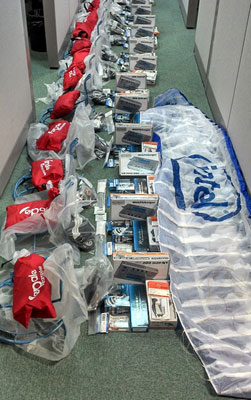Let's build an autonomous drone!
 Unmanned aerial vehicles are a fashionable and promising theme, created by both professional designers of robotics and enthusiasts, including students. However, to create a truly intellectual drone is still difficult for those and for others. Someone rests on the limitations of the hardware platform, others can not solve software problems, while others simply do not have enough money to finish the job.
Unmanned aerial vehicles are a fashionable and promising theme, created by both professional designers of robotics and enthusiasts, including students. However, to create a truly intellectual drone is still difficult for those and for others. Someone rests on the limitations of the hardware platform, others can not solve software problems, while others simply do not have enough money to finish the job.Now imagine that Intel has provided you with everything you need to create an intelligent autonomous drone: a powerful on-board computer, a full set of aviation components, and software that can revive all of the above hardware.
Now imagine that all this went completely free ! Do you think this does not happen? No, the Intel Do-It-Yourself Challenge happens. See, all the sets are even ready!
Intel is ready to provide ready-made kits (hardware + on-board computer + software) to any university in Russia that has applied for the competition. The task of the participants is to implement a project to adapt the drone to any specific goals: research, rescue, transport, etc.

As a think tank of a drone, it is proposed to use an Android smartphone on the Intel platform: it has all the interfaces needed to control the device, sensors, and, of course, computing power that is quite enough for our purposes. Well, the popularity of the platform facilitates the development of software for it.
')

The aircraft itself is designed as a paraglider with a motor. This design is easy to manage, sufficiently lifting and autonomous. To control the engine and controls, we chose the Pololu Maestro board. The servo controller is connected to the smartphone via USB or Bluetooth.
The set of software provided includes:
- Basic Android application for controlling the engine and steering wheels - the basis of your future development;
- Android application for remote control of a drone via 3G networks;
- Windows application to control the drone with gestures. Here is how it looks in practice.
So, we are looking for 20 universities where enthusiastic students and teachers work and study. The task will be difficult and time consuming, but worth it. What is required to enter the competition? First, gather a group of enthusiasts from your school - this is not the case alone. Secondly, to find an interested curator from among the teachers, for sure there will also be such. And thirdly, declare yourself by writing a letter to the organizer of the contest Paul Guermonprez (in English, of course). He can also ask any questions about the competition.
Please note that 20 sets will be distributed among educational institutions in the EMEA region, in other words, Europe and Asia. The more actively you respond to this call, the more sets will come to Russia.
Good luck and creative success!
Source: https://habr.com/ru/post/200336/
All Articles